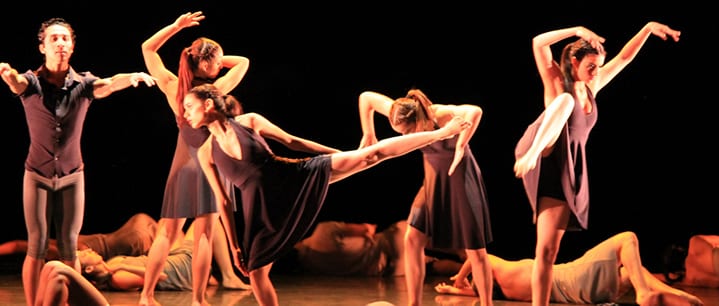 Contemporary dance is the most expressive and subjective dance form, making it more accessible to outsiders and helpful as a supplement to other dance training. Contemporary choreography techniques help dancers harness the energy and emotion of their own bodies, resulting in a more fluid and organic form of movement that can appear effortless and completely improvised to the casual observer.
Contemporary dance is the most expressive and subjective dance form, making it more accessible to outsiders and helpful as a supplement to other dance training. Contemporary choreography techniques help dancers harness the energy and emotion of their own bodies, resulting in a more fluid and organic form of movement that can appear effortless and completely improvised to the casual observer.
You have a lot of options when it comes to learning, practicing, and performing modern dance. And with the vast resources on the Internet these days, you might be wondering if you can forgo the studio and learn contemporary dance online, just by watching a few YouTube videos. But the truth is, that doesn’t always work. Here’s why online videos won’t replace the guidance you’ll get from working with a dance teacher:
1. Supervision helps you correct poor form before it becomes habit.
Some dancers and instructors use modern technology to teach dance, reaching out to online audiences by uploading video tutorials and even live-streaming lessons and performances. However, no matter how closely you observe them, your computer screen is like a one-way mirror: they can’t see you. So when you learn contemporary dance online, no one can correct slight differences of posture, form, or balance. As every dancer knows, that’s how you develop unbreakable bad habits.
The experience of a contemporary dance class is wildly different from that of a ballet class. However, just because there’s more creative freedom, that doesn’t mean there isn’t a right way and a wrong way to perform certain alignments, angles, and postures. Contemporary techniques might be fluid, but they’re also very precise. A few important elements of effective contemporary dance training include:
- Controlled breathing
- Focusing on the torso, rather than the limbs
- Articulated releases (ending contact with a surface or partner)
- Flexibility (twisting muscles and joints into unusual angles)
These techniques require physical touch and sight for proper instruction. Release techniques, for example, train the lungs, joints, and muscles to work together, using breath and movement to both portray and experience extreme relief.
2. Supervision prevents injury.
You’ll need to practice each new technique over and over again before you can safely and comfortably dance on your own. Even if your only goal is to burn calories, your safety and health depend on avoiding injury, using the right muscles, and progressing at a pace that matches your skill level. Just because professional contemporary dancers make it look effortless, that doesn’t mean their dance moves are easy! A particular leap may require a certain amount of muscle control to avoid dangerous missteps. Working with a dance instructor will help you condition your body to avoid injury, and will also supervise your movements along the way.
3. Professional spaces are well-lit and safe.
Martha Graham and Merce Cunningham, who founded and popularized the schools of modern and contemporary dance, stressed how important it was to make full use of one’s physical space. Contemporary dance is about forming a relationship with the space around you. It’s near impossible to learn contemporary dance online because these professional amenities are instrumental:
- Barres to warm up and stretch at the right angles
- Proper lighting and floor-to-ceiling mirrors, to accurately observe your own form
- Hard flooring to imitate the stage and provide proper traction and support
3. Performing gives you a chance to grow under the spotlight.
Performance is an integral part of truly mastering any dance genre. Just as you can’t learn a new language without speaking it, you can’t learn contemporary dance without actually moving across the stage and reacting to the music. You can further reap the full rewards of dance by participating in live recitals, productions, and even competitions. Learning and rehearsing choreography, as well as adapting to new performance venues, make you a better dancer.
4. Dancing with a partner or team teaches trust, compromise, and collaboration.
Mental flexibility is just as important as physical flexibility in contemporary dance. With its emphasis on creativity and self-expression, it’s important not to limit your perspective to your own range of movement or even your own comfort zone. Collaborating with other dancers is an invaluable experience that helps you identify your own strengths and weaknesses, but contemporary dancers can transcend the limits of more formal schools and shape one another’s repertoire of form and movement. For example, you might not have considered a particular pose or even facial gesture until a fellow dancer tries it during a free-dance exercise.
Contact improvisation is another staple of contemporary dance, especially if you’re dancing with a partner. You must adapt your dancing not only to the music, but to your partner, while focusing on the exchange of weight and touch. This requires trust, compromise, respect, humility, and intimacy – and only comes with practice.
While sports teach teamwork and yoga offers stress relief, contemporary dance turns students into more creative, open-minded people. When dancers share in the experience together, especially under a dance teachers’s expert guidance, the possibilities for future growth are even greater. Have fun exploring the world of dance!
Photo by Gabriel Saldana
Megan L.

